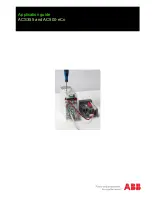
NOVUS AUTOMATION
1/3
TxRail 4-20 mA Transmitter
TEMPERATURE TRANSMITTER - OPERATING MANUAL – V1.2x F
CONFIGURAÇÃO
If the default configuration or the ordered configuration satisfies the
application, then no further configuration is necessary and the
transmitter is ready to be used. If a new setting is desired, this can be
accomplished by the TxConfig and sent to the transmitter through
the TxConfig Interface.
The TxConfig Interface and Software compose the Transmitter
Configuration Kit, which can be purchased separately. The latest
release of this software can be downloaded from our web site. To
install, run the Tx_setup.exe and follow the instructions.
Serial port configuration errors may occur when other software
are sharing the same serial port. Close all serial port
applications prior to using the TxConfig software.
The TxConfig interface connects the transmitter to the PC, as shown
in Fig. 1 and 2. There are two types of interface: TxConfig-RS232 and
TxConfig-USB.
Fig. 1 – TxConfig Interface connections model RS232
Fig. 2 – TxConfig Interface USB connections
Once the connection is accomplished, the software shows the
configuration options of the transmitter model attached. Access the
Help for usage instructions.
Fig. 3 shows the TxConfig software main screen.
Fig. 3 – TxConfig main screen
The fields in the screen mean:
1.
Input Sensor: Choose the desired temperature sensor among
the available options. See Table 1.
2.
Measuring Range: Defines the output scale for the input sensor.
Program here the measurement Lower Range Value and the
Upper Range Value.
When the Low Scale Limit is configured with a value higher than the
Full Scale Limit, the current output will have a decrescent behavior
(20~4 mA).
The values configured in these fields can not be beyond the
sensor measuring range. The minimum span value has to be
observed as well. See Table 1.
3.
Line Noise Rejection: The transmitter incorporates a digital filter
to cancel the induced noise from the 50 or 60 Hz systems. For
better performance, select the line frequency used in your
country.
4.
Sensor Failure Detection: establishes the transmitter output
behavior (upscale or down-scale) in the presence of a sensor fail.
5.
Zero Correction: Allows for small sensor corrections. See item
Operating.
6.
Device Information: The Device Information box contains
relevant data concerning a particular transmitter. Please pass
along this information when contacting the technical assistance
department.
7.
Read Device: Brings to the screen the current transmitter
parameters configuration.
8.
Apply: Sends a new configuration to the transmitter.
Note: The factory default configuration is (unless otherwise specified
or ordered):
Pt100 input, 0 to 100 °C.
60 Hz filtering and up scale (20 mA) output for sensor fail.





















